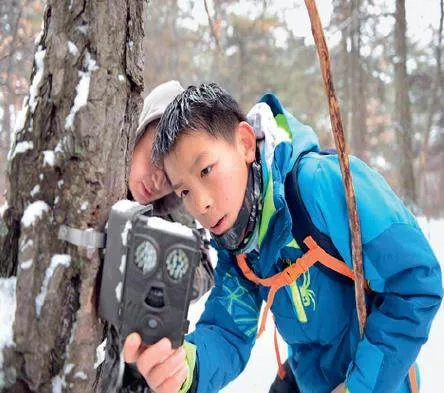A Young Leopard Seeker Speaks at COP29



A cub advocate shares his inspiringjourney of wildlife conservation andclimate action at COP29.
GAO Shiqing, a 10th-grade student at KeystoneAcademy in Beijing, is a youth environmentalambassador for the All-China Environment Federationand a volunteer for the Chinese FelidConservation Alliance (CFCA). As the only minor NGOobserver from China attending COP29 in Baku, Azerbai-jan, Gao delivered a speech titled “Me, Beijing, and ClimateAction” at a side event called China’s Solutions toPromote Public Climate Action.
Gao’s story with wild animals began with the NorthChina leopard. Few people know that the original habitatof this type of leopard was the mountainous regionto the west and north of Beijing. Around 2005, the NorthChina leopard vanished due to the destruction of itshabitat, and Beijing lost this iconic native animal. Thenin 2017, the CFCA began assessing biodiversity in northChina mountains to evaluate the potential of restoringthe leopard population in Beijing. The idea of “restoring”did not mean transporting leopards directly into Beijing’s mountains by air, but assessing the area’s foodchain, ensuring the continuity of ecological corridors inthe Taihang Mountain, and stopping human hunting toallow the species to return to its original habitat in Beijingnaturally. In 2018, nine-year-old Gao started volunteeringwith this project and has since been involved inthe process of finding the leopard and bringing it home.After six years, what is the status of the North Chinaleopard? Has it returned to Beijing?
China Today (CT ): Did you find the leopard? Can youtell us about the process of looking for it?
Gao Shiqing: First, we needed to find out where thenearest leopard population was. In 2016, a stable groupof about 40 leopards was recorded in Mafang Township,Heshun County of north China’s Shanxi Province, about400 kilometers from Beijing. It was the closest recordedwild North China leopard population to Beijing at thetime. In 2020, we recorded a North China leopard livingin the Tuoliang National Nature Reserve, Hebei Province,about 300 kilometers from Beijing. At that time, it wasthe closest known leopard to Beijing. This news wasshared at COP15, where I was dubbed China’s “YoungLeopard Seeker.” Then in 2023, a North China leopardwas spotted in Chengnanzhuang Town, Baoding City ofHebei Province, about 200 kilometers from Beijing.
From 400 kilometers to 300 kilometers and then to200 kilometers, it felt as if we could hear the footsteps ofthe North China leopard returning to Beijing. Unfortunately,leopards still have not been spotted in the mountainousregion surrounding Beijing. In 2024, I trekkedthrough the Taihang Mountain and Yanshan Mountainranges around Beijing but found no trace of any leopard.
CT : Apart from looking for the North China leopard,have you also assessed whether or not the TaihangMountain and Beijing’s forests are currently suitable forleopards with a complete food chain?
Gao: Yes, our research involves settingup infrared cameras in the mountains,collecting footage at regular intervals,and randomly capturing images of wildlifeto calculate their activity frequency. Iselected two observation sites: one nearthe Baihe Grand Canyon in Yanqing (P1)and the other in the mountainous areaof Changshaoying Township in Huairou (P2). One is located near high mountains and rivers witha diverse vertical mountain ecosystem, while the otheris nestled in a forest area containing a mix of conifersand broad-leaf trees, presenting a horizontally variedecosystem. Together, these two points have providedcomplementary evidence that it could support a leopardpopulation.。
CT : What have you found?
Gao: P1 is the original habitat of the leopard cat.We have discovered its droppings scattered aroundthe surrounding hills, showing that there is a thrivingpopulation. Through pattern identification in infraredcamera images, we recorded around 20 leopard cats livingin 1,000 square meters. The living conditions for theleopard cat population have been exceptionally great inBeijing’s northern mountains, and they have been frequentlycaptured on camera in recent years. However,finding even one leopard cat was rare adecade ago. The number of other animalsliving on the small hill at P1 is also large,showing a strong biodiversity.
The P2 observation site is the only placeon the outskirts of Beijing that can trulybe called a primeval forest. This foresthas a mixture of coniferous and broadleafplants, unlike the current monocultureplantations commonly seen in other mountainous areas. It features largeareas of oak trees. Oak leaves are notwaxy, enabling them to decomposequickly, and the trees produce acornsduring the fall, which serve as the idealfood for many animals living in thenorth China forests.
At P2, we recorded many mid-sizedwild animals. The increase in the numberof these animals in Beijing’s forestsis encouraging. Badgers usually weigh around 10 kilograms,roe deer about 30 kilograms, gorals 50 kilograms,and adult wild boars often exceed 100 kilograms, all ofwhich serve as an ample food source for North Chinaleopards.
At P2, we also discovered the red fox for the first time.This mid-sized carnivore has not been spotted in Beijingfor over two decades. Three years ago, it was recordedon Lingshan Mountain in western Beijing. Now, we havealso discovered it in the northern mountains of Huairou,probably the first time for this area. When will largecarnivores return to Beijing’s forests? This question hasbeen discussed for years, yet the return of North Chinaleopards, wolves, and jackals seems like a distant prospect.But then unexpectedly, the red fox quietly returned.It’s still uncertain whether or not it is a remnant of Beijing’soriginal red fox population or if itmigrated from nearby Hebei Province.
During the past six years, my feelingis that the food chain for the NorthChina leopard in Beijing’s mountainousareas is gradually increasing. However,the numbers and continuity still needfurther observation.
CT : What is the present status of theNorth China leopard?
Gao: Well, we don’t know when it will return. As natureworks in mysterious ways, it might return at a timewe least expect. All we can do is maintain low-carbonpractices, restore ecosystems, pave the way for its return,and wait patiently.
CT : What are your feelings about attending COP29?
Gao: Whether or not the North China leopard returnsto Beijing is not what truly matters. What matters mostis our action to protect our ecosystem. With the intricateweb of life, nature provides us with sound mechanismsto tackle the challenges we face. Ecosystems withrich biodiversity are our invaluable allies in mitigatingand adapting to climate change. By protecting and restoringthese ecological systems, we can safeguard variouskinds of species and enhance nature’s potential forcarbon sequestration, thus strengthening our planet’sresilience. Our action plan is to promote these synergies,support biodiversity conservation, and mitigate the impactsbrought by climate change through the power ofnature.
Facing climate change, displaced animals, and endangeredspecies, we must start acting today!
CT : What do you think of the speeches from manycountries’ representatives at COP29?
Gao: This conference brought together 50,000 to60,000 people from various organizations and groupsworldwide. It struck me that each person in this largecrowd of people is like a seed. After the conference,they will return to their countries, take root, and grow,becoming the most passionate advocates for ecologicalprotection and low-carbon and green development. Eachyear, more people will join us, influencing even morepeople until this issue will become a consensus for allhumanity.

